BalanceBit Software: Analysis and Design
VerifiedAdded on 2023/02/01
|7
|3174
|28
AI Summary
This document provides an analysis and design of BalanceBit software, including user requirements, use case diagram, use case specifications, analysis class diagram, and use case realization. The document covers various aspects of the software, such as synchronizing data between the wrist device and the desktop application, creating user groups, and generating reports. The analysis and design are based on the provided scenario and requirements.
Contribute Materials
Your contribution can guide someone’s learning journey. Share your
documents today.

1
IN2013 Object-Oriented Analysis and Design
2022/23 Coursework Assignment 1 (Analysis)
BalanceBit Software
Dr Peter T. Popov
Version 1.0
September 27th, 2022
Document History
1. New Document.
Introduction
There will be two pieces of coursework for IN2013, each worth 45% of the total mark for the
module.
This coursework assignment tests your knowledge on object-oriented analysis. You are asked
to analyse a scenario and then develop a set of user requirements and analysis models for the
software system described in the scenario.
The deadline for this coursework is 17:00 on 13 th of November 2022, and all work must
be submitted electronically in accordance with the guidelines below.
IN2013 Object-Oriented Analysis and Design
2022/23 Coursework Assignment 1 (Analysis)
BalanceBit Software
Dr Peter T. Popov
Version 1.0
September 27th, 2022
Document History
1. New Document.
Introduction
There will be two pieces of coursework for IN2013, each worth 45% of the total mark for the
module.
This coursework assignment tests your knowledge on object-oriented analysis. You are asked
to analyse a scenario and then develop a set of user requirements and analysis models for the
software system described in the scenario.
The deadline for this coursework is 17:00 on 13 th of November 2022, and all work must
be submitted electronically in accordance with the guidelines below.
Secure Best Marks with AI Grader
Need help grading? Try our AI Grader for instant feedback on your assignments.
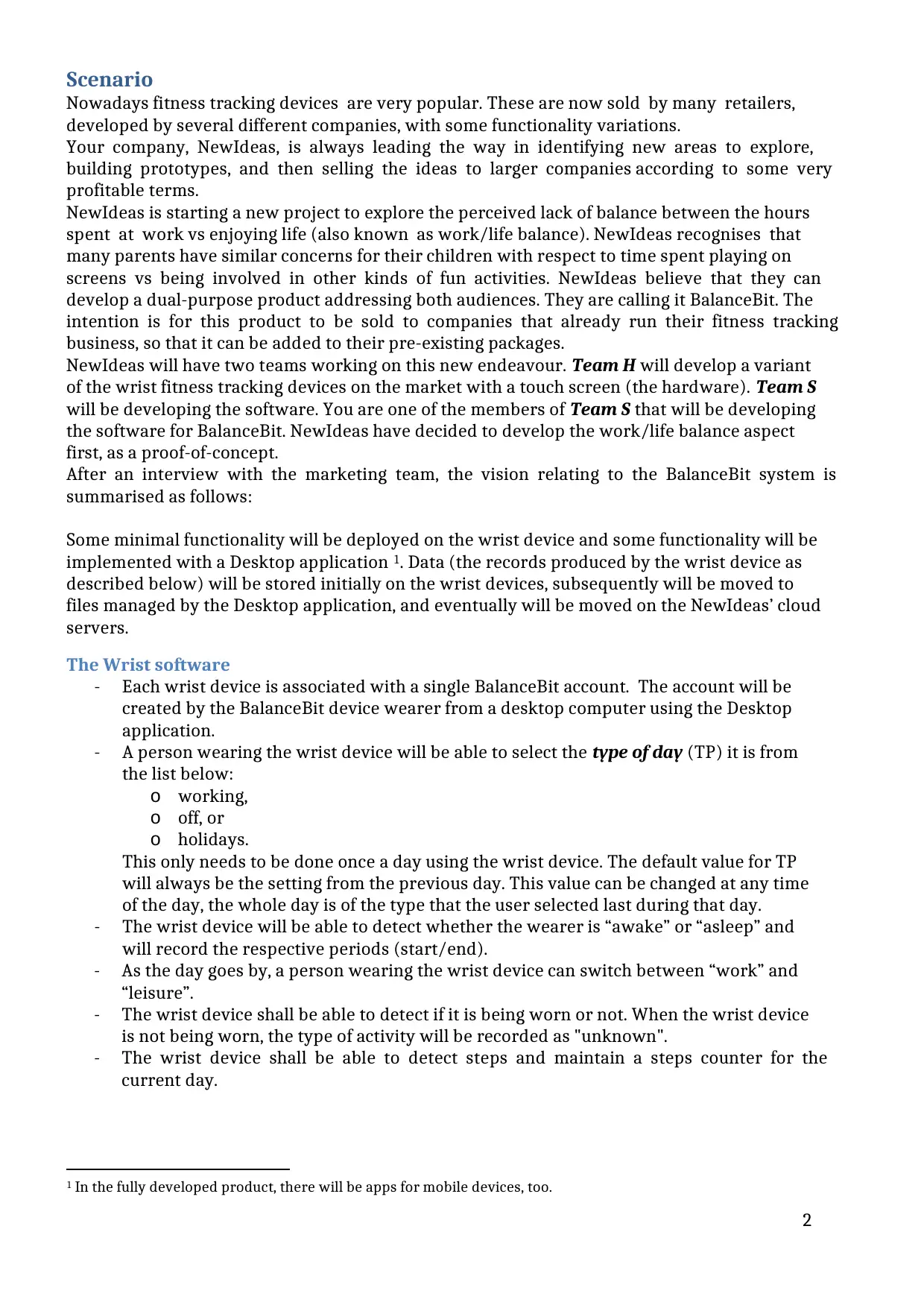
2
Scenario
Nowadays fitness tracking devices are very popular. These are now sold by many retailers,
developed by several different companies, with some functionality variations.
Your company, NewIdeas, is always leading the way in identifying new areas to explore,
building prototypes, and then selling the ideas to larger companies according to some very
profitable terms.
NewIdeas is starting a new project to explore the perceived lack of balance between the hours
spent at work vs enjoying life (also known as work/life balance). NewIdeas recognises that
many parents have similar concerns for their children with respect to time spent playing on
screens vs being involved in other kinds of fun activities. NewIdeas believe that they can
develop a dual-purpose product addressing both audiences. They are calling it BalanceBit. The
intention is for this product to be sold to companies that already run their fitness tracking
business, so that it can be added to their pre-existing packages.
NewIdeas will have two teams working on this new endeavour. Team H will develop a variant
of the wrist fitness tracking devices on the market with a touch screen (the hardware). Team S
will be developing the software. You are one of the members of Team S that will be developing
the software for BalanceBit. NewIdeas have decided to develop the work/life balance aspect
first, as a proof-of-concept.
After an interview with the marketing team, the vision relating to the BalanceBit system is
summarised as follows:
Some minimal functionality will be deployed on the wrist device and some functionality will be
implemented with a Desktop application 1. Data (the records produced by the wrist device as
described below) will be stored initially on the wrist devices, subsequently will be moved to
files managed by the Desktop application, and eventually will be moved on the NewIdeas’ cloud
servers.
The Wrist software
- Each wrist device is associated with a single BalanceBit account. The account will be
created by the BalanceBit device wearer from a desktop computer using the Desktop
application.
- A person wearing the wrist device will be able to select the type of day (TP) it is from
the list below:
o working,
o off, or
o holidays.
This only needs to be done once a day using the wrist device. The default value for TP
will always be the setting from the previous day. This value can be changed at any time
of the day, the whole day is of the type that the user selected last during that day.
- The wrist device will be able to detect whether the wearer is “awake” or “asleep” and
will record the respective periods (start/end).
- As the day goes by, a person wearing the wrist device can switch between “work” and
“leisure”.
- The wrist device shall be able to detect if it is being worn or not. When the wrist device
is not being worn, the type of activity will be recorded as "unknown".
- The wrist device shall be able to detect steps and maintain a steps counter for the
current day.
1 In the fully developed product, there will be apps for mobile devices, too.
Scenario
Nowadays fitness tracking devices are very popular. These are now sold by many retailers,
developed by several different companies, with some functionality variations.
Your company, NewIdeas, is always leading the way in identifying new areas to explore,
building prototypes, and then selling the ideas to larger companies according to some very
profitable terms.
NewIdeas is starting a new project to explore the perceived lack of balance between the hours
spent at work vs enjoying life (also known as work/life balance). NewIdeas recognises that
many parents have similar concerns for their children with respect to time spent playing on
screens vs being involved in other kinds of fun activities. NewIdeas believe that they can
develop a dual-purpose product addressing both audiences. They are calling it BalanceBit. The
intention is for this product to be sold to companies that already run their fitness tracking
business, so that it can be added to their pre-existing packages.
NewIdeas will have two teams working on this new endeavour. Team H will develop a variant
of the wrist fitness tracking devices on the market with a touch screen (the hardware). Team S
will be developing the software. You are one of the members of Team S that will be developing
the software for BalanceBit. NewIdeas have decided to develop the work/life balance aspect
first, as a proof-of-concept.
After an interview with the marketing team, the vision relating to the BalanceBit system is
summarised as follows:
Some minimal functionality will be deployed on the wrist device and some functionality will be
implemented with a Desktop application 1. Data (the records produced by the wrist device as
described below) will be stored initially on the wrist devices, subsequently will be moved to
files managed by the Desktop application, and eventually will be moved on the NewIdeas’ cloud
servers.
The Wrist software
- Each wrist device is associated with a single BalanceBit account. The account will be
created by the BalanceBit device wearer from a desktop computer using the Desktop
application.
- A person wearing the wrist device will be able to select the type of day (TP) it is from
the list below:
o working,
o off, or
o holidays.
This only needs to be done once a day using the wrist device. The default value for TP
will always be the setting from the previous day. This value can be changed at any time
of the day, the whole day is of the type that the user selected last during that day.
- The wrist device will be able to detect whether the wearer is “awake” or “asleep” and
will record the respective periods (start/end).
- As the day goes by, a person wearing the wrist device can switch between “work” and
“leisure”.
- The wrist device shall be able to detect if it is being worn or not. When the wrist device
is not being worn, the type of activity will be recorded as "unknown".
- The wrist device shall be able to detect steps and maintain a steps counter for the
current day.
1 In the fully developed product, there will be apps for mobile devices, too.
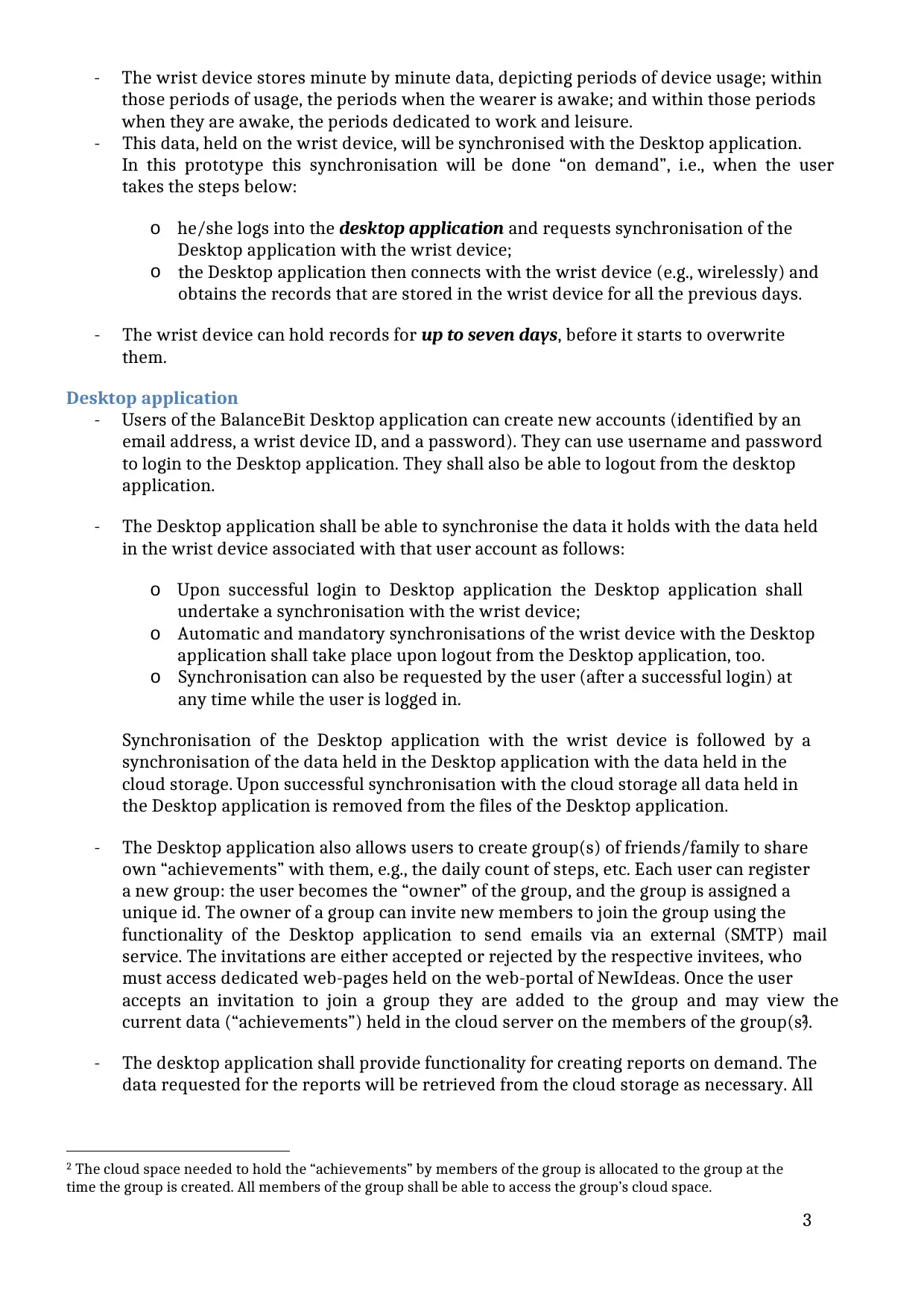
3
- The wrist device stores minute by minute data, depicting periods of device usage; within
those periods of usage, the periods when the wearer is awake; and within those periods
when they are awake, the periods dedicated to work and leisure.
- This data, held on the wrist device, will be synchronised with the Desktop application.
In this prototype this synchronisation will be done “on demand”, i.e., when the user
takes the steps below:
o he/she logs into the desktop application and requests synchronisation of the
Desktop application with the wrist device;
o the Desktop application then connects with the wrist device (e.g., wirelessly) and
obtains the records that are stored in the wrist device for all the previous days.
- The wrist device can hold records for up to seven days, before it starts to overwrite
them.
Desktop application
- Users of the BalanceBit Desktop application can create new accounts (identified by an
email address, a wrist device ID, and a password). They can use username and password
to login to the Desktop application. They shall also be able to logout from the desktop
application.
- The Desktop application shall be able to synchronise the data it holds with the data held
in the wrist device associated with that user account as follows:
o Upon successful login to Desktop application the Desktop application shall
undertake a synchronisation with the wrist device;
o Automatic and mandatory synchronisations of the wrist device with the Desktop
application shall take place upon logout from the Desktop application, too.
o Synchronisation can also be requested by the user (after a successful login) at
any time while the user is logged in.
Synchronisation of the Desktop application with the wrist device is followed by a
synchronisation of the data held in the Desktop application with the data held in the
cloud storage. Upon successful synchronisation with the cloud storage all data held in
the Desktop application is removed from the files of the Desktop application.
- The Desktop application also allows users to create group(s) of friends/family to share
own “achievements” with them, e.g., the daily count of steps, etc. Each user can register
a new group: the user becomes the “owner” of the group, and the group is assigned a
unique id. The owner of a group can invite new members to join the group using the
functionality of the Desktop application to send emails via an external (SMTP) mail
service. The invitations are either accepted or rejected by the respective invitees, who
must access dedicated web-pages held on the web-portal of NewIdeas. Once the user
accepts an invitation to join a group they are added to the group and may view the
current data (“achievements”) held in the cloud server on the members of the group(s)2.
- The desktop application shall provide functionality for creating reports on demand. The
data requested for the reports will be retrieved from the cloud storage as necessary. All
2 The cloud space needed to hold the “achievements” by members of the group is allocated to the group at the
time the group is created. All members of the group shall be able to access the group’s cloud space.
- The wrist device stores minute by minute data, depicting periods of device usage; within
those periods of usage, the periods when the wearer is awake; and within those periods
when they are awake, the periods dedicated to work and leisure.
- This data, held on the wrist device, will be synchronised with the Desktop application.
In this prototype this synchronisation will be done “on demand”, i.e., when the user
takes the steps below:
o he/she logs into the desktop application and requests synchronisation of the
Desktop application with the wrist device;
o the Desktop application then connects with the wrist device (e.g., wirelessly) and
obtains the records that are stored in the wrist device for all the previous days.
- The wrist device can hold records for up to seven days, before it starts to overwrite
them.
Desktop application
- Users of the BalanceBit Desktop application can create new accounts (identified by an
email address, a wrist device ID, and a password). They can use username and password
to login to the Desktop application. They shall also be able to logout from the desktop
application.
- The Desktop application shall be able to synchronise the data it holds with the data held
in the wrist device associated with that user account as follows:
o Upon successful login to Desktop application the Desktop application shall
undertake a synchronisation with the wrist device;
o Automatic and mandatory synchronisations of the wrist device with the Desktop
application shall take place upon logout from the Desktop application, too.
o Synchronisation can also be requested by the user (after a successful login) at
any time while the user is logged in.
Synchronisation of the Desktop application with the wrist device is followed by a
synchronisation of the data held in the Desktop application with the data held in the
cloud storage. Upon successful synchronisation with the cloud storage all data held in
the Desktop application is removed from the files of the Desktop application.
- The Desktop application also allows users to create group(s) of friends/family to share
own “achievements” with them, e.g., the daily count of steps, etc. Each user can register
a new group: the user becomes the “owner” of the group, and the group is assigned a
unique id. The owner of a group can invite new members to join the group using the
functionality of the Desktop application to send emails via an external (SMTP) mail
service. The invitations are either accepted or rejected by the respective invitees, who
must access dedicated web-pages held on the web-portal of NewIdeas. Once the user
accepts an invitation to join a group they are added to the group and may view the
current data (“achievements”) held in the cloud server on the members of the group(s)2.
- The desktop application shall provide functionality for creating reports on demand. The
data requested for the reports will be retrieved from the cloud storage as necessary. All
2 The cloud space needed to hold the “achievements” by members of the group is allocated to the group at the
time the group is created. All members of the group shall be able to access the group’s cloud space.
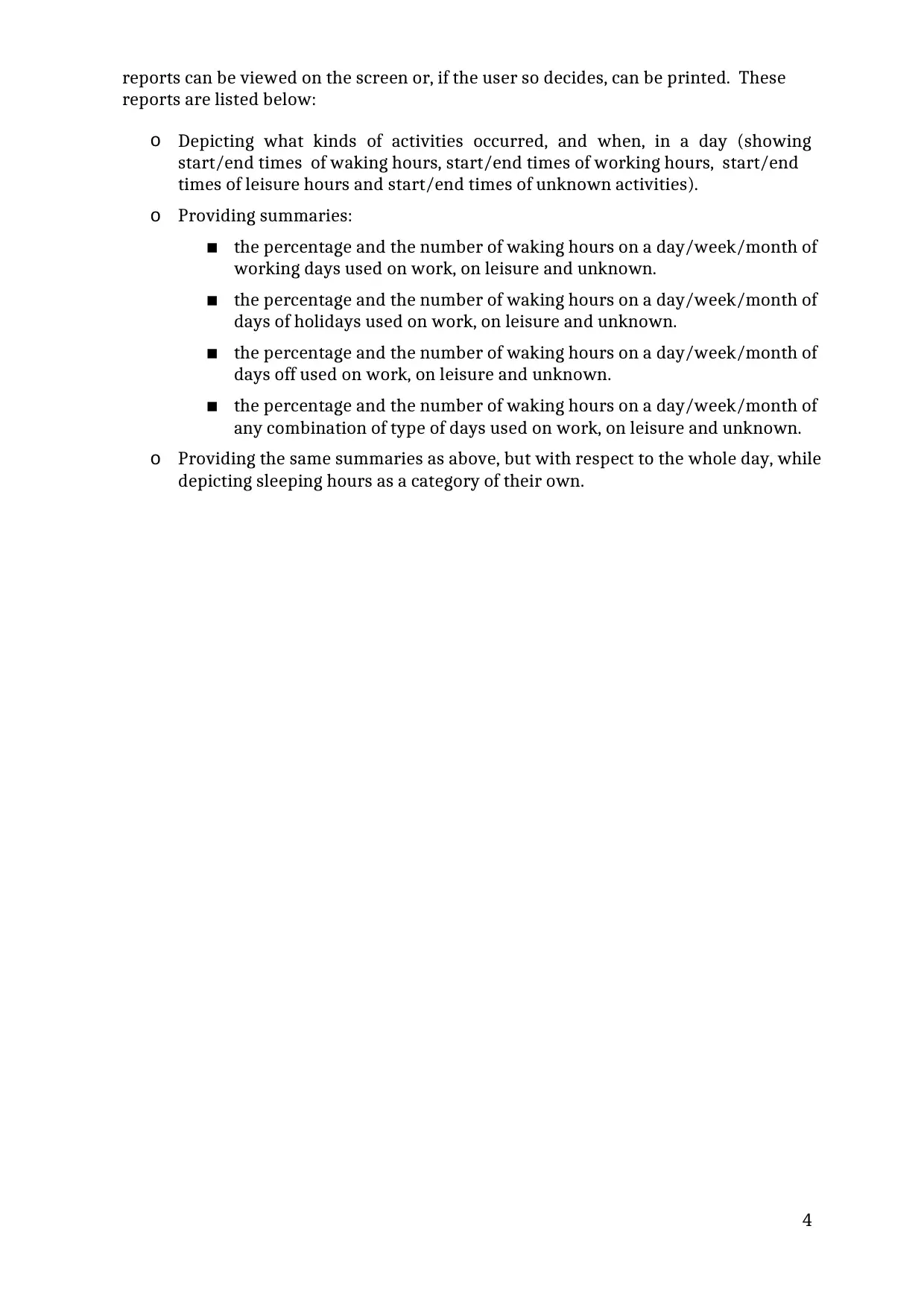
4
reports can be viewed on the screen or, if the user so decides, can be printed. These
reports are listed below:
o Depicting what kinds of activities occurred, and when, in a day (showing
start/end times of waking hours, start/end times of working hours, start/end
times of leisure hours and start/end times of unknown activities).
o Providing summaries:
▪ the percentage and the number of waking hours on a day/week/month of
working days used on work, on leisure and unknown.
▪ the percentage and the number of waking hours on a day/week/month of
days of holidays used on work, on leisure and unknown.
▪ the percentage and the number of waking hours on a day/week/month of
days off used on work, on leisure and unknown.
▪ the percentage and the number of waking hours on a day/week/month of
any combination of type of days used on work, on leisure and unknown.
o Providing the same summaries as above, but with respect to the whole day, while
depicting sleeping hours as a category of their own.
reports can be viewed on the screen or, if the user so decides, can be printed. These
reports are listed below:
o Depicting what kinds of activities occurred, and when, in a day (showing
start/end times of waking hours, start/end times of working hours, start/end
times of leisure hours and start/end times of unknown activities).
o Providing summaries:
▪ the percentage and the number of waking hours on a day/week/month of
working days used on work, on leisure and unknown.
▪ the percentage and the number of waking hours on a day/week/month of
days of holidays used on work, on leisure and unknown.
▪ the percentage and the number of waking hours on a day/week/month of
days off used on work, on leisure and unknown.
▪ the percentage and the number of waking hours on a day/week/month of
any combination of type of days used on work, on leisure and unknown.
o Providing the same summaries as above, but with respect to the whole day, while
depicting sleeping hours as a category of their own.
Secure Best Marks with AI Grader
Need help grading? Try our AI Grader for instant feedback on your assignments.
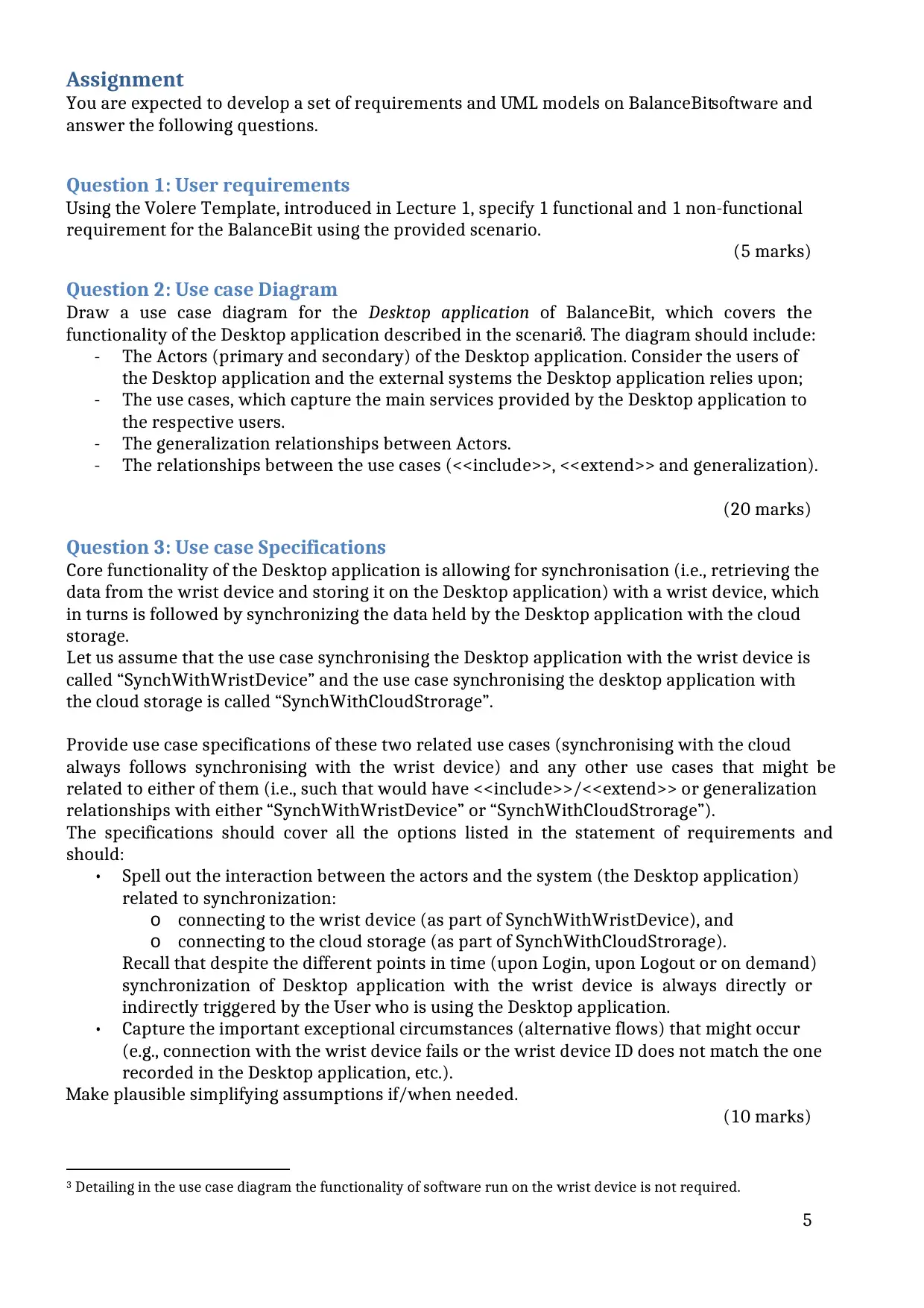
5
Assignment
You are expected to develop a set of requirements and UML models on BalanceBitsoftware and
answer the following questions.
Question 1: User requirements
Using the Volere Template, introduced in Lecture 1, specify 1 functional and 1 non-functional
requirement for the BalanceBit using the provided scenario.
(5 marks)
Question 2: Use case Diagram
Draw a use case diagram for the Desktop application of BalanceBit, which covers the
functionality of the Desktop application described in the scenario3. The diagram should include:
- The Actors (primary and secondary) of the Desktop application. Consider the users of
the Desktop application and the external systems the Desktop application relies upon;
- The use cases, which capture the main services provided by the Desktop application to
the respective users.
- The generalization relationships between Actors.
- The relationships between the use cases (<<include>>, <<extend>> and generalization).
(20 marks)
Question 3: Use case Specifications
Core functionality of the Desktop application is allowing for synchronisation (i.e., retrieving the
data from the wrist device and storing it on the Desktop application) with a wrist device, which
in turns is followed by synchronizing the data held by the Desktop application with the cloud
storage.
Let us assume that the use case synchronising the Desktop application with the wrist device is
called “SynchWithWristDevice” and the use case synchronising the desktop application with
the cloud storage is called “SynchWithCloudStrorage”.
Provide use case specifications of these two related use cases (synchronising with the cloud
always follows synchronising with the wrist device) and any other use cases that might be
related to either of them (i.e., such that would have <<include>>/<<extend>> or generalization
relationships with either “SynchWithWristDevice” or “SynchWithCloudStrorage”).
The specifications should cover all the options listed in the statement of requirements and
should:
• Spell out the interaction between the actors and the system (the Desktop application)
related to synchronization:
o connecting to the wrist device (as part of SynchWithWristDevice), and
o connecting to the cloud storage (as part of SynchWithCloudStrorage).
Recall that despite the different points in time (upon Login, upon Logout or on demand)
synchronization of Desktop application with the wrist device is always directly or
indirectly triggered by the User who is using the Desktop application.
• Capture the important exceptional circumstances (alternative flows) that might occur
(e.g., connection with the wrist device fails or the wrist device ID does not match the one
recorded in the Desktop application, etc.).
Make plausible simplifying assumptions if/when needed.
(10 marks)
3 Detailing in the use case diagram the functionality of software run on the wrist device is not required.
Assignment
You are expected to develop a set of requirements and UML models on BalanceBitsoftware and
answer the following questions.
Question 1: User requirements
Using the Volere Template, introduced in Lecture 1, specify 1 functional and 1 non-functional
requirement for the BalanceBit using the provided scenario.
(5 marks)
Question 2: Use case Diagram
Draw a use case diagram for the Desktop application of BalanceBit, which covers the
functionality of the Desktop application described in the scenario3. The diagram should include:
- The Actors (primary and secondary) of the Desktop application. Consider the users of
the Desktop application and the external systems the Desktop application relies upon;
- The use cases, which capture the main services provided by the Desktop application to
the respective users.
- The generalization relationships between Actors.
- The relationships between the use cases (<<include>>, <<extend>> and generalization).
(20 marks)
Question 3: Use case Specifications
Core functionality of the Desktop application is allowing for synchronisation (i.e., retrieving the
data from the wrist device and storing it on the Desktop application) with a wrist device, which
in turns is followed by synchronizing the data held by the Desktop application with the cloud
storage.
Let us assume that the use case synchronising the Desktop application with the wrist device is
called “SynchWithWristDevice” and the use case synchronising the desktop application with
the cloud storage is called “SynchWithCloudStrorage”.
Provide use case specifications of these two related use cases (synchronising with the cloud
always follows synchronising with the wrist device) and any other use cases that might be
related to either of them (i.e., such that would have <<include>>/<<extend>> or generalization
relationships with either “SynchWithWristDevice” or “SynchWithCloudStrorage”).
The specifications should cover all the options listed in the statement of requirements and
should:
• Spell out the interaction between the actors and the system (the Desktop application)
related to synchronization:
o connecting to the wrist device (as part of SynchWithWristDevice), and
o connecting to the cloud storage (as part of SynchWithCloudStrorage).
Recall that despite the different points in time (upon Login, upon Logout or on demand)
synchronization of Desktop application with the wrist device is always directly or
indirectly triggered by the User who is using the Desktop application.
• Capture the important exceptional circumstances (alternative flows) that might occur
(e.g., connection with the wrist device fails or the wrist device ID does not match the one
recorded in the Desktop application, etc.).
Make plausible simplifying assumptions if/when needed.
(10 marks)
3 Detailing in the use case diagram the functionality of software run on the wrist device is not required.
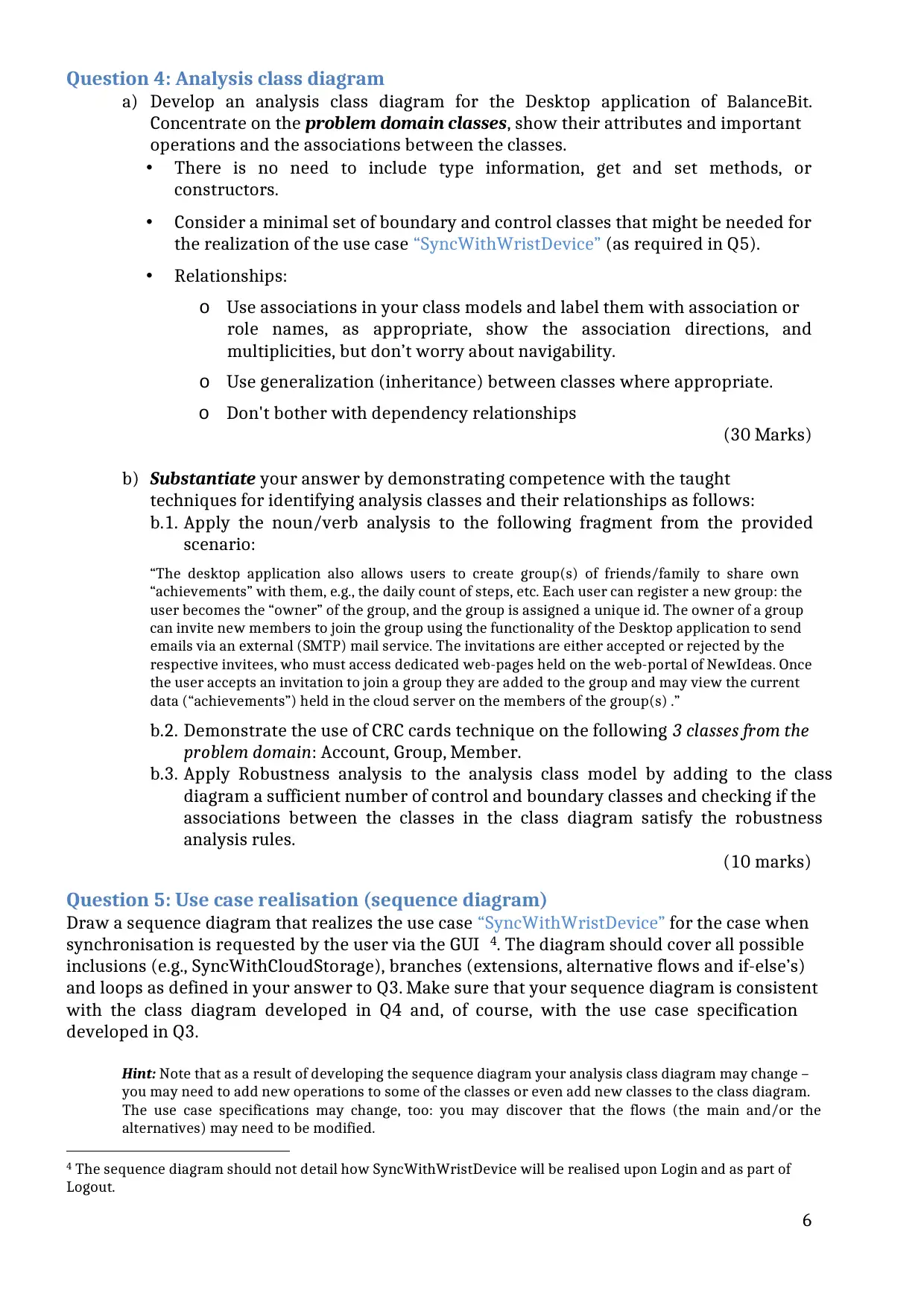
6
Question 4: Analysis class diagram
a) Develop an analysis class diagram for the Desktop application of BalanceBit.
Concentrate on the problem domain classes, show their attributes and important
operations and the associations between the classes.
• There is no need to include type information, get and set methods, or
constructors.
• Consider a minimal set of boundary and control classes that might be needed for
the realization of the use case “SyncWithWristDevice” (as required in Q5).
• Relationships:
o Use associations in your class models and label them with association or
role names, as appropriate, show the association directions, and
multiplicities, but don’t worry about navigability.
o Use generalization (inheritance) between classes where appropriate.
o Don't bother with dependency relationships
(30 Marks)
b) Substantiate your answer by demonstrating competence with the taught
techniques for identifying analysis classes and their relationships as follows:
b.1. Apply the noun/verb analysis to the following fragment from the provided
scenario:
“The desktop application also allows users to create group(s) of friends/family to share own
“achievements” with them, e.g., the daily count of steps, etc. Each user can register a new group: the
user becomes the “owner” of the group, and the group is assigned a unique id. The owner of a group
can invite new members to join the group using the functionality of the Desktop application to send
emails via an external (SMTP) mail service. The invitations are either accepted or rejected by the
respective invitees, who must access dedicated web-pages held on the web-portal of NewIdeas. Once
the user accepts an invitation to join a group they are added to the group and may view the current
data (“achievements”) held in the cloud server on the members of the group(s) .”
b.2. Demonstrate the use of CRC cards technique on the following 3 classes from the
problem domain: Account, Group, Member.
b.3. Apply Robustness analysis to the analysis class model by adding to the class
diagram a sufficient number of control and boundary classes and checking if the
associations between the classes in the class diagram satisfy the robustness
analysis rules.
(10 marks)
Question 5: Use case realisation (sequence diagram)
Draw a sequence diagram that realizes the use case “SyncWithWristDevice” for the case when
synchronisation is requested by the user via the GUI 4. The diagram should cover all possible
inclusions (e.g., SyncWithCloudStorage), branches (extensions, alternative flows and if-else’s)
and loops as defined in your answer to Q3. Make sure that your sequence diagram is consistent
with the class diagram developed in Q4 and, of course, with the use case specification
developed in Q3.
Hint: Note that as a result of developing the sequence diagram your analysis class diagram may change –
you may need to add new operations to some of the classes or even add new classes to the class diagram.
The use case specifications may change, too: you may discover that the flows (the main and/or the
alternatives) may need to be modified.
4 The sequence diagram should not detail how SyncWithWristDevice will be realised upon Login and as part of
Logout.
Question 4: Analysis class diagram
a) Develop an analysis class diagram for the Desktop application of BalanceBit.
Concentrate on the problem domain classes, show their attributes and important
operations and the associations between the classes.
• There is no need to include type information, get and set methods, or
constructors.
• Consider a minimal set of boundary and control classes that might be needed for
the realization of the use case “SyncWithWristDevice” (as required in Q5).
• Relationships:
o Use associations in your class models and label them with association or
role names, as appropriate, show the association directions, and
multiplicities, but don’t worry about navigability.
o Use generalization (inheritance) between classes where appropriate.
o Don't bother with dependency relationships
(30 Marks)
b) Substantiate your answer by demonstrating competence with the taught
techniques for identifying analysis classes and their relationships as follows:
b.1. Apply the noun/verb analysis to the following fragment from the provided
scenario:
“The desktop application also allows users to create group(s) of friends/family to share own
“achievements” with them, e.g., the daily count of steps, etc. Each user can register a new group: the
user becomes the “owner” of the group, and the group is assigned a unique id. The owner of a group
can invite new members to join the group using the functionality of the Desktop application to send
emails via an external (SMTP) mail service. The invitations are either accepted or rejected by the
respective invitees, who must access dedicated web-pages held on the web-portal of NewIdeas. Once
the user accepts an invitation to join a group they are added to the group and may view the current
data (“achievements”) held in the cloud server on the members of the group(s) .”
b.2. Demonstrate the use of CRC cards technique on the following 3 classes from the
problem domain: Account, Group, Member.
b.3. Apply Robustness analysis to the analysis class model by adding to the class
diagram a sufficient number of control and boundary classes and checking if the
associations between the classes in the class diagram satisfy the robustness
analysis rules.
(10 marks)
Question 5: Use case realisation (sequence diagram)
Draw a sequence diagram that realizes the use case “SyncWithWristDevice” for the case when
synchronisation is requested by the user via the GUI 4. The diagram should cover all possible
inclusions (e.g., SyncWithCloudStorage), branches (extensions, alternative flows and if-else’s)
and loops as defined in your answer to Q3. Make sure that your sequence diagram is consistent
with the class diagram developed in Q4 and, of course, with the use case specification
developed in Q3.
Hint: Note that as a result of developing the sequence diagram your analysis class diagram may change –
you may need to add new operations to some of the classes or even add new classes to the class diagram.
The use case specifications may change, too: you may discover that the flows (the main and/or the
alternatives) may need to be modified.
4 The sequence diagram should not detail how SyncWithWristDevice will be realised upon Login and as part of
Logout.
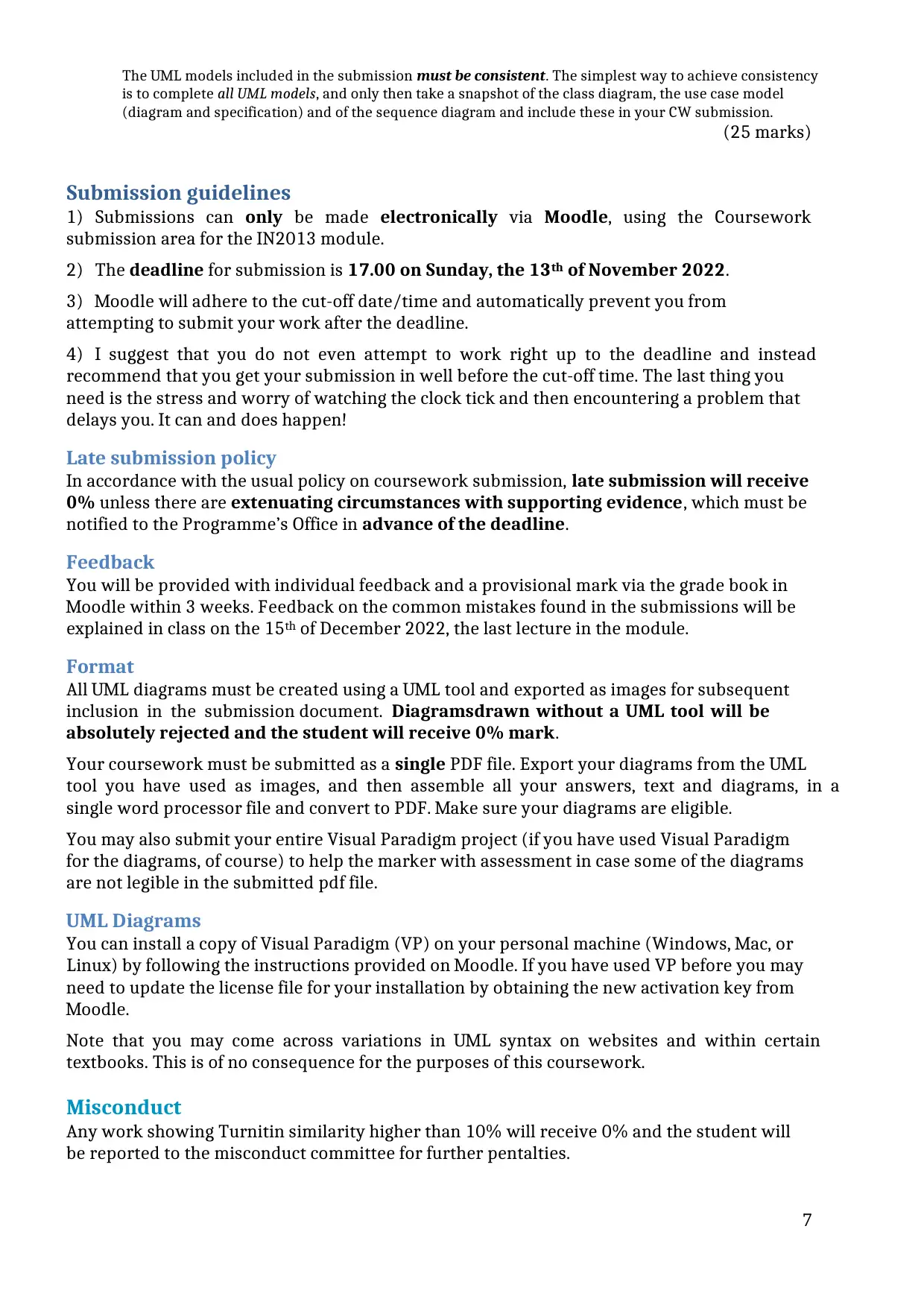
7
The UML models included in the submission must be consistent. The simplest way to achieve consistency
is to complete all UML models, and only then take a snapshot of the class diagram, the use case model
(diagram and specification) and of the sequence diagram and include these in your CW submission.
(25 marks)
Submission guidelines
1) Submissions can only be made electronically via Moodle, using the Coursework
submission area for the IN2013 module.
2) The deadline for submission is 17.00 on Sunday, the 13th of November 2022.
3) Moodle will adhere to the cut-off date/time and automatically prevent you from
attempting to submit your work after the deadline.
4) I suggest that you do not even attempt to work right up to the deadline and instead
recommend that you get your submission in well before the cut-off time. The last thing you
need is the stress and worry of watching the clock tick and then encountering a problem that
delays you. It can and does happen!
Late submission policy
In accordance with the usual policy on coursework submission, late submission will receive
0% unless there are extenuating circumstances with supporting evidence, which must be
notified to the Programme’s Office in advance of the deadline.
Feedback
You will be provided with individual feedback and a provisional mark via the grade book in
Moodle within 3 weeks. Feedback on the common mistakes found in the submissions will be
explained in class on the 15th of December 2022, the last lecture in the module.
Format
All UML diagrams must be created using a UML tool and exported as images for subsequent
inclusion in the submission document. Diagramsdrawn without a UML tool will be
absolutely rejected and the student will receive 0% mark.
Your coursework must be submitted as a single PDF file. Export your diagrams from the UML
tool you have used as images, and then assemble all your answers, text and diagrams, in a
single word processor file and convert to PDF. Make sure your diagrams are eligible.
You may also submit your entire Visual Paradigm project (if you have used Visual Paradigm
for the diagrams, of course) to help the marker with assessment in case some of the diagrams
are not legible in the submitted pdf file.
UML Diagrams
You can install a copy of Visual Paradigm (VP) on your personal machine (Windows, Mac, or
Linux) by following the instructions provided on Moodle. If you have used VP before you may
need to update the license file for your installation by obtaining the new activation key from
Moodle.
Note that you may come across variations in UML syntax on websites and within certain
textbooks. This is of no consequence for the purposes of this coursework.
Misconduct
Any work showing Turnitin similarity higher than 10% will receive 0% and the student will
be reported to the misconduct committee for further pentalties.
The UML models included in the submission must be consistent. The simplest way to achieve consistency
is to complete all UML models, and only then take a snapshot of the class diagram, the use case model
(diagram and specification) and of the sequence diagram and include these in your CW submission.
(25 marks)
Submission guidelines
1) Submissions can only be made electronically via Moodle, using the Coursework
submission area for the IN2013 module.
2) The deadline for submission is 17.00 on Sunday, the 13th of November 2022.
3) Moodle will adhere to the cut-off date/time and automatically prevent you from
attempting to submit your work after the deadline.
4) I suggest that you do not even attempt to work right up to the deadline and instead
recommend that you get your submission in well before the cut-off time. The last thing you
need is the stress and worry of watching the clock tick and then encountering a problem that
delays you. It can and does happen!
Late submission policy
In accordance with the usual policy on coursework submission, late submission will receive
0% unless there are extenuating circumstances with supporting evidence, which must be
notified to the Programme’s Office in advance of the deadline.
Feedback
You will be provided with individual feedback and a provisional mark via the grade book in
Moodle within 3 weeks. Feedback on the common mistakes found in the submissions will be
explained in class on the 15th of December 2022, the last lecture in the module.
Format
All UML diagrams must be created using a UML tool and exported as images for subsequent
inclusion in the submission document. Diagramsdrawn without a UML tool will be
absolutely rejected and the student will receive 0% mark.
Your coursework must be submitted as a single PDF file. Export your diagrams from the UML
tool you have used as images, and then assemble all your answers, text and diagrams, in a
single word processor file and convert to PDF. Make sure your diagrams are eligible.
You may also submit your entire Visual Paradigm project (if you have used Visual Paradigm
for the diagrams, of course) to help the marker with assessment in case some of the diagrams
are not legible in the submitted pdf file.
UML Diagrams
You can install a copy of Visual Paradigm (VP) on your personal machine (Windows, Mac, or
Linux) by following the instructions provided on Moodle. If you have used VP before you may
need to update the license file for your installation by obtaining the new activation key from
Moodle.
Note that you may come across variations in UML syntax on websites and within certain
textbooks. This is of no consequence for the purposes of this coursework.
Misconduct
Any work showing Turnitin similarity higher than 10% will receive 0% and the student will
be reported to the misconduct committee for further pentalties.
1 out of 7
Your All-in-One AI-Powered Toolkit for Academic Success.
+13062052269
info@desklib.com
Available 24*7 on WhatsApp / Email
![[object Object]](/_next/static/media/star-bottom.7253800d.svg)
Unlock your academic potential
© 2024 | Zucol Services PVT LTD | All rights reserved.